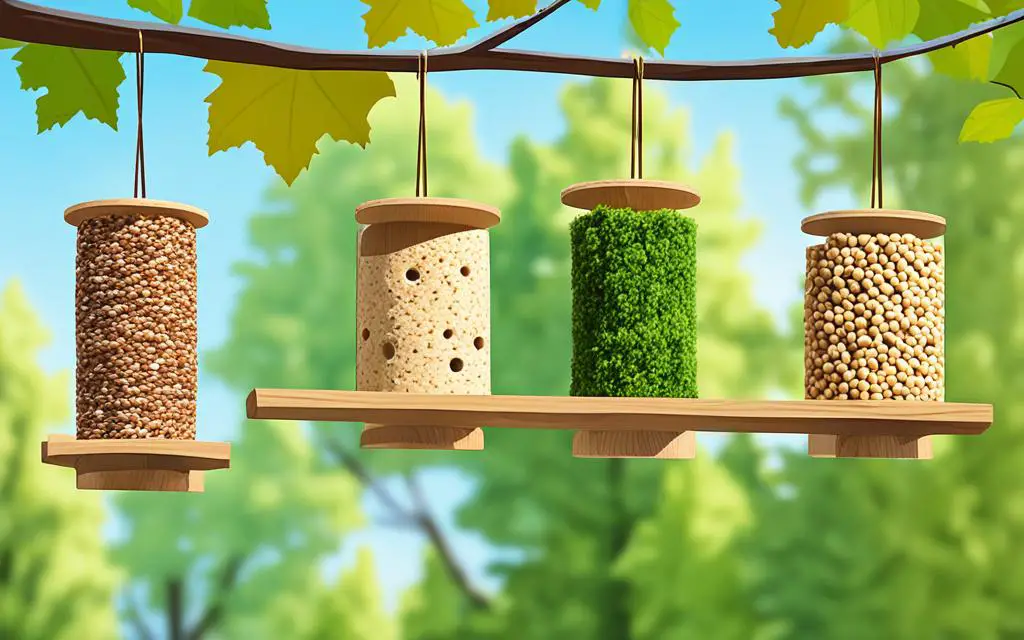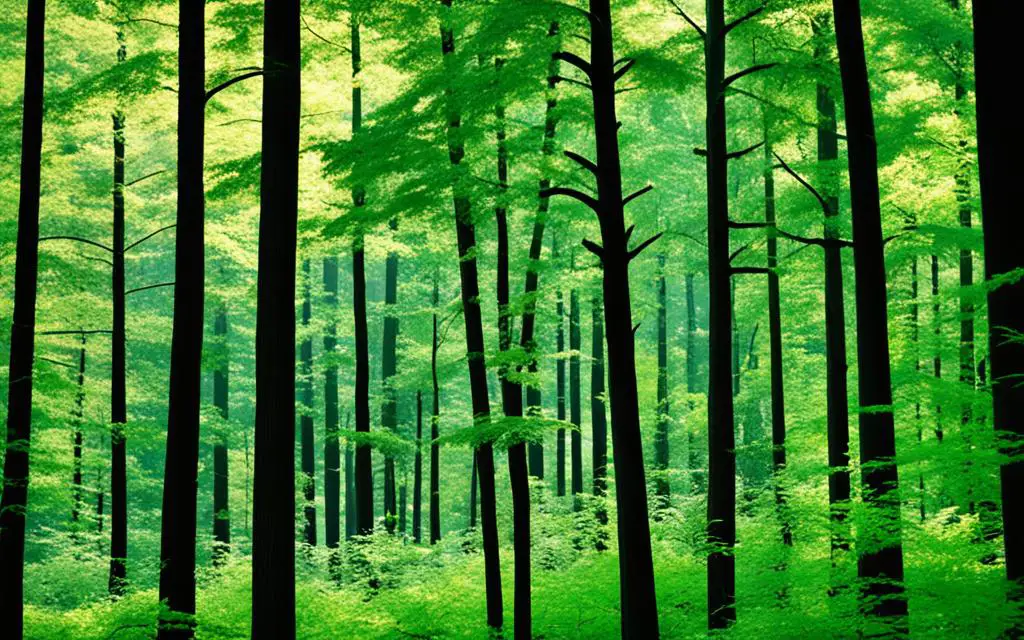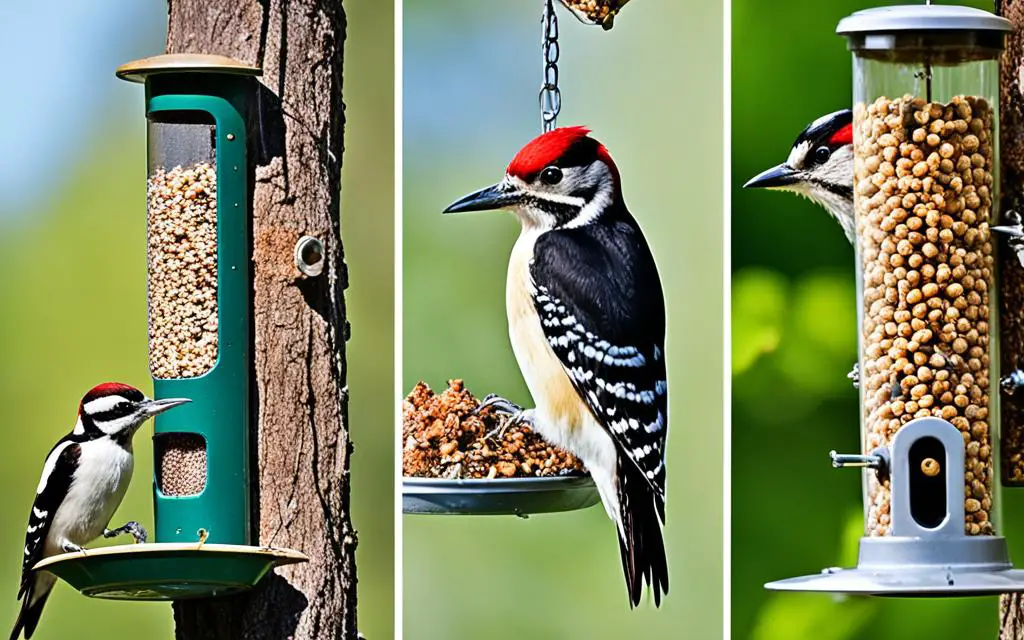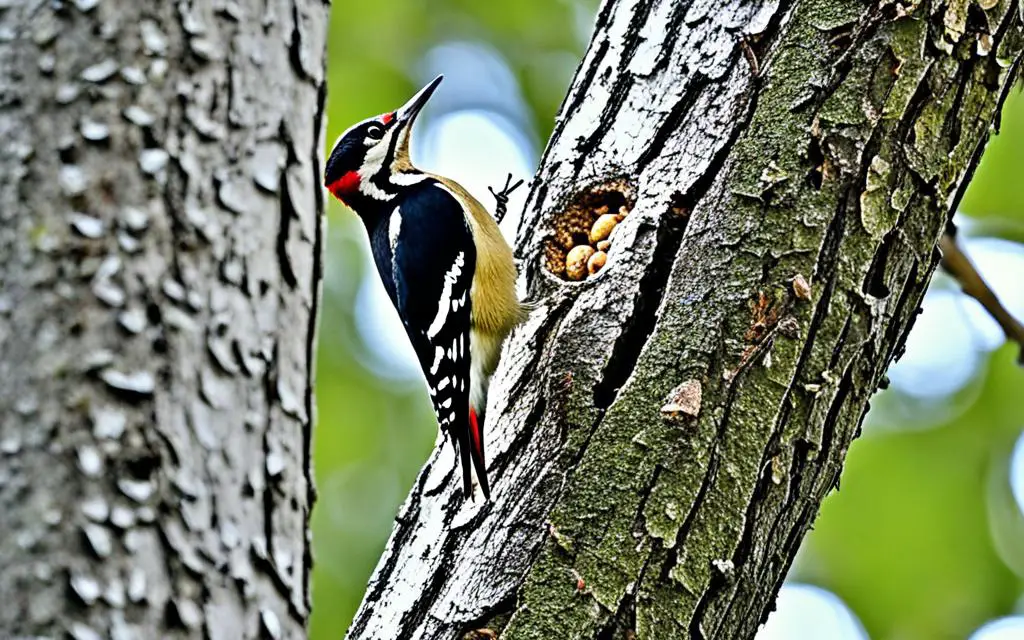Did you know there are over 200 woodpecker species worldwide? In the United States alone, you can find 22 types. These birds are not just nice to look at. They’re important for our environment. If you want woodpeckers in your yard, keep reading. I’ll tell you 7 ways to make it happen.
Woodpeckers are fascinating birds, and they’re pretty fun to watch. You can find them in various places. We’ll show you 7 tips to draw woodpeckers near. Some of these tips work quickly, so you might see woodpeckers in just a few hours.
Key Takeaways
- Woodpeckers are diverse and fascinating birds found throughout the United States.
- Offering the right foods and feeders can quickly attract woodpeckers to your yard.
- Providing a welcoming habitat with trees and water sources is crucial for long-term woodpecker visits.
- Avoiding harmful pesticides and encouraging natural predators helps protect woodpeckers.
- Installing suitable nest boxes can encourage woodpeckers to breed and raise their young in your backyard.
Offer Irresistible Woodpecker Foods
To attract woodpeckers to your yard, offer foods they enjoy. These include peanuts, sunflower seeds, and suet. A mix of woodpecker attractants can bring various types of woodpeckers to your yard.
Peanuts: A Protein and Fat-Packed Treat
Peanuts are ideal for woodpeckers, being rich in fat and protein. This helps them stay energized, especially in the cold.
Sunflower Seeds: A Versatile Favorite
Woodpeckers love sunflower seeds because they are tasty and easy to eat. These seeds attract many other bird species too.
Mealworms: Live or Dried, a Nutritious Delicacy
Live or dried mealworms are a great protein source for birds. They are high in fat and protein, making them an excellent food choice.
Suet: The Ultimate Woodpecker Delight
Suet is a top woodpecker food, packed with energy. It comes from animal fat and is very attractive to woodpeckers.
Provide Woodpecker-Friendly Feeders
To invite woodpeckers to your yard, use feeders that match their eating habits. Woodpeckers need feeders that fit their skills and tastes. They are strong and skilled birds, so certain feeder types work better for them.
I am including a link to one of the best woodpecker feeders on the market today!
Suet Cake Feeders: The Classic Choice
Suet cake feeders are top picks for feeding woodpeckers. With metal cages holding suet cakes, they are easy for woodpeckers to use. The design lets woodpeckers hold on and peck at the suet for energy, a vital food source in winter when backyard bird watching is best.
Mesh Tube Feeders: Versatile and Accessible
Mesh tube feeders work well for woodpecker feeders too. They allow for a variety of food like suet balls and peanuts. Woodpeckers can easily grab these options by hanging onto the feeder with their strong beaks.
Vertical Log Feeders: Mimicking Nature
Vertical log feeders with suet plugs offer a natural dining setting. They mirror how woodpeckers eat from trees. This design makes them feel at home while enjoying their food.

Create a Welcoming Habitat
Woodpeckers need a good place to live. They use trees for many things like shelter and looking for food. If you don’t have a lot of trees where you live, think about planting some. Even small trees can help woodpeckers a lot as they grow.
Embrace Dead and Decaying Trees
Don’t rush to cut down dead trees. They are important for woodpeckers. These trees are softer, making it easier for woodpeckers to find food. By leaving these trees, you can make your yard a better place for woodpeckers to live.
Plant Native Trees for Long-Term Benefits
Planting trees that are native to your area is a smart move. These trees give woodpeckers a good place to live and find food. They attract more insects, which are a woodpecker’s main source of food. Your yard will become a great home for woodpeckers if you plant a mix of native trees.

7 Proven Ways to Attract Woodpeckers
Want woodpeckers in your yard? Try these 7 tips. They will make your backyard a place where these amazing birds want to be:
1. Offer irresistible woodpecker foods like peanuts, sunflower seeds, mealworms, and suet. These foods are full of what woodpeckers need.
2. Use woodpecker-friendly feeders like suet cake feeders, mesh tube feeders, and vertical log feeders. They make it easy for woodpeckers to get to the food.
3. Make a welcoming habitat by keeping dead or decaying trees and planting native species. This provides food and nesting spots for woodpeckers.
4. Don’t cut down dead trees. They are important for woodpeckers as they use them for food and nests. They help keep the woodpecker population strong.
5. Put up nest boxes to help woodpeckers raise their young in your yard. You’ll get to see their family life up close.
6. Provide a clean water source with a birdbath or fountain. Woodpeckers need it for drinking and bathing.
7. Avoid using harmful pesticides. They can hurt woodpeckers and the bugs they eat. Protecting woodpeckers is important.

Using these tips, you can turn your yard into a woodpecker magnet. Get ready to watch these birds bring life and beauty to your space!
Nest Boxes: A Home for Woodpecker Families
If there are no dead trees for woodpeckers to nest in your yard, worry not. You can put up woodpecker nesting boxes instead. These boxes invite woodpeckers to breed and care for their chicks. Most woodpeckers will be happy to use these boxes. This way, you not only attract woodpeckers but also enjoy backyard bird watching.
Choosing the Right Nest Box
Choosing the right woodpecker nesting box is key. It must be designed for woodpeckers with the right size, hole, and build. Local experts can suggest the perfect box for your area. They can help choose the right one for the woodpecker species in your region.
If you are interested in having your own nesting box for outdoors, I am including that link.
Proper Installation and Maintenance
Putting up your woodpecker nesting box correctly is very important. These birds like their boxes on trees or posts, 10-15 feet high. Make sure the box faces away from the wind. Clean the box after each nesting season. This keeps it a cozy and safe place for breeding and raising young ones.
Provide Clean Water Sources
Setting up a birdbath or fountain is key to inviting woodpeckers into your yard for [backyard bird watching]. These features offer water for drinking and a place for woodpeckers to groom. Grooming is vital for their feathers and health.
Birdbaths and Fountains
Place birdbaths and fountains strategically in your yard to draw woodpeckers. A good spot is near trees or bushes to make the birds feel safer. Also, putting them in open places helps bird watchers spot them easily.
Maintaining a Clean Water Supply
Keeping the water clean is crucial. This means changing it often and cleaning out any dirt or algae. Using a water heater in winter stops it from freezing, ensuring a year-round water source for birds.
Avoid Harmful Pesticides
Pesticides are a big danger to woodpeckers and their homes. These chemicals can get into the bugs woodpeckers eat. This messes up their eating, which can lower the woodpecker population. Pesticides can also poison woodpeckers, harming how they reproduce or even killing them.
Integrated Pest Management
An Integrated Pest Management (IPM) strategy is key. It uses many ways to prevent pests without just chemicals. It aims to use less toxic pesticides. This helps keep woodpeckers and all wildlife safe and keeps ecosystems healthy.
Encouraging Natural Predators
Encouraging natural predators is a smart way to use fewer harmful pesticides. Birds of prey, snakes, and small mammals are some natural enemies of pests. By inviting these animals, you help create a natural pest control system. This method supports woodpeckers and the wider ecosystem.
FAQ
What are the best foods to attract woodpeckers to my yard?
What types of feeders work best for woodpeckers?
How can I create a welcoming habitat for woodpeckers in my yard?
Should I install a nest box to attract woodpeckers?
Why is it important to provide a clean water source for woodpeckers?
How can pesticides impact woodpeckers in my yard?
Source Links

My name is Shane Warren, the author behind Your Bird Buddy – your ultimate guide to the wonderful world of birds! Unleash your inner avian explorer as we delve into a vibrant library of knowledge dedicated to all things feathered. From learning about diverse bird species from across the globe to understanding their captivating habitats and behaviors, I’m here to fuel your passion for these magnificent creatures. Not only that, but I also provide valuable insights on being a responsible and informed pet bird owner. Join our vibrant community and let’s celebrate the feathered wonders of the world together – one chirp at a time. And be sure to join our Your Bird Buddy Community over on Facebook!


Comments are closed